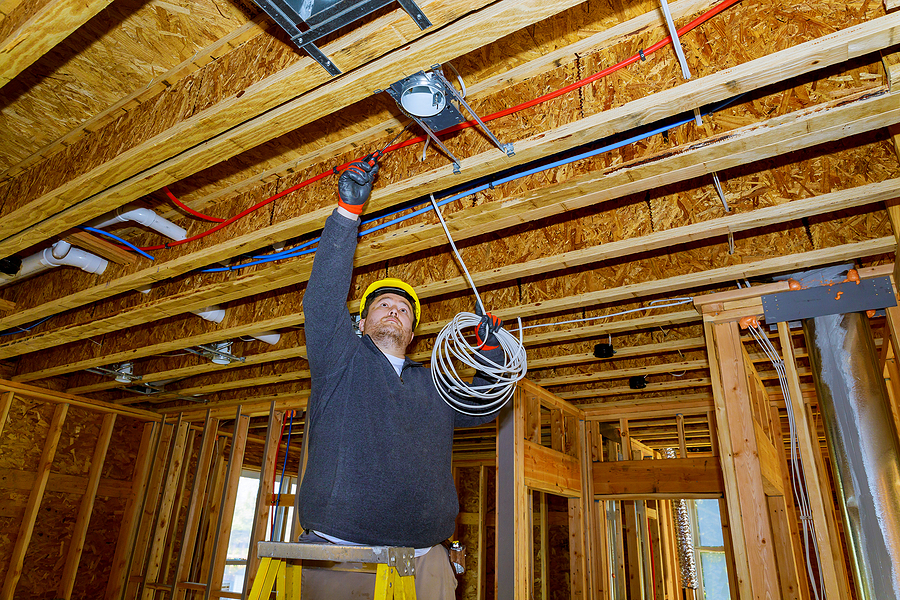Home Electrical Wiring Basics

This handy article will help you understand how wiring works and how to operate the wires in your home’s electrical system. All the wires that carry electricity from a power source to lights, appliances, and other electrical equipment are called “electrical wire.”
All a house’s lights, switches, outlets, and electrical appliances are powered by various wires and cables. Smaller cables and wires are used to distribute electricity throughout the house.
Copper is the most common metal used in domestic wiring, while aluminum is rarely employed. Electrical charge (and heat) is kept in the wire by a rubber, plastic, or paper-like layer known as insulation, which acts as a barrier (this insulation is stripped from the ends of the wires where connections are made). Grounding is done with conductors that are not insulated.
How Does Electrical Wiring Work?
All forms of cable and wire are usually referred to as “wire.” A single conductor is a single piece of wire; a cable is a group of single conductors twisted together or wrapped in a sheath.
Like roads can handle more traffic, prominent conductors can carry more power than tiny ones. An AWG (American Wire Gauge) number indicates the diameter of a metal conductor; the lower the number, the thicker the wire. They are used in home lighting and receptacle circuits. AWG 14 or AWG 12 wire is usually used for this.
There are several additional types of wire in the house, including those for the phone, cable television, stereo speakers, and so on, and primary electrical wire. Wires that run at low voltage or transmit audio or video signals rather than electrical power are less likely to convey hazardous electrical currents.
Electrical Wire Repair & Care
Because of the fire threat caused by defective wiring, any issues with electrical circuits must be identified and repaired promptly. As we go over the most common issues with electrical wiring, we point you toward further information that might assist in narrowing down your options. Electrical cables and plugs are among the most common causes of difficulties, as they can degrade over time. Replace them with our instructions.
Projects for Do-It-Yourself Electrical Wiring
All the house wiring jobs you can handle yourself are in this part of electrical wiring. To get you started, we’ll go over some fundamentals like how to strip and cut wires and how to cut and rip the electrical cable. After that, we’ll show you how to extend an electrical circuit and install a new electrical box, two everyday tasks. It’s essential to turn off electricity to the circuit before you start working on it.
Typical electrical appliances
Here are the tools you’ll need for almost any electrical repair if you’re interested in learning how to do it yourself.
Voltage Tester
A voltage tester that does not necessitate physical contact. Using a non-contact voltage tester, you may find out if cables or electrical equipment are charged without opening or detaching the wires. Detectors like the one shown are meant to detect standard voltage in electrical lines and cords like those illustrated in the image. This device can also identify low-voltage devices, such as security, communications, entertainment, and garden sprinklers. Put it into any standard wall socket for instant results on whether the circuit is “hot” (charged) or correctly grounded.
Continuity Tester
Battery-powered continuity testers are available for about $10. It may be used to check whether a circuit’s wiring is damaged or not.
Lineman’s Pliers
Using a set of lineman’s pliers is the most acceptable way to cut and twist thick wire or cable. It is essential to keep your pliers pointed at the wires so that you may twist them in a counter-clockwise manner while holding them together with one hand.
The Long-Nose Pliers
Long-nose pliers are handy when working with thin wire loops or cutting wires (most include a wire-cutting section). The pointed end of the pliers may be used to make a smooth, 3/4-circle at the end of a wire, which is meant to fit around a screw termination (always hook the wire onto the terminal with the end of the bend sweeping clockwise from the wire).
Multimeter
A multimeter comes in handy for various activities, such as verifying continuity, voltage, and more. For the best results, follow the manufacturer’s directions to the letter. You can buy multimeters for less than $20 at most consumer electronics retailers that perform the same functions as ohmmeters, volt meters, and other instruments.
Insulated Screwdrivers
You’ll need a variety of insulated screwdrivers for electricians. Make confident you have both flat-bladed and Phillips-head drivers on hand.
Wire stripper
Insulation is a plastic, rubber, or paper layer that stops conductors from shorting against one another or delivering a shock to the user when plugged in. An affordable wire stripper makes it easy to remove insulation from wires before splicing or connecting them to equipment. You should use a stripper with a slit large enough to cut the insulation but small enough to avoid nicking wire conductors.
